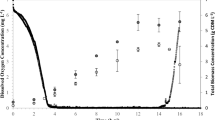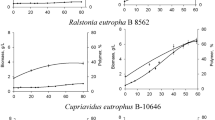Abstract
Fed-batch culture ofPseudomonas oleovorans was carried out for the production of medium-chain-length polyhydroxyalkanoates (MCL-PHAs) using octanoate as a carbon source. Octanoate and the salt solution containing ammonium sulfate and magnesium sulfate were intermittently fed in the course of fermentation. Cell mass and PHA concentrations of 42.8 and 16.8 g/L, respectively, could be obtained in 40 h. The PHA content and the PHA productivity were 39.2% and 0.42 g PHA/L-h, respectively. The yields of cell mass and PHA were 0.71 g dry cell mass/goctanoate and 0.28 g PHA/g octanoate, respectively. Therefore, octanoate can be used for the production of MCL-PHAs to a high, concentration with high productvity.
Similar content being viewed by others
References
Anderson, A. J. and E. A. Dawes (1990) Occurrence, metabolism, metabolic role, and industrial uses of bacterial polyhydroxyalkanoates.Microbiol Rev. 54: 450–472.
Doi, Y. (1990)Microbial Polyesters. VCH Publishers New York, NY.
Steinbuchel, A. (1991) Polyhydroxyalkanoic, acids. p. 124–213 In D. Byrom (ed.)Biomaterials: Novel Materials from Biological Sources. Stockton Press, New York, NY.
Lee, S. Y. and H. N. Chang (1995) Production of poly-(hydroxy alkanoic acid).Adv. Biochem. Eng. Biotechnol. 52: 27–58.
Lee, S. Y. (1996) Bacterial polyhydroxyalkanoates.Biotechnol. Bioeng. 49: 1–14.
Lee, S. Y. (1996) Plastic bacteria?: Progress and prospects for polyhydroxyalkanoate production in bacteria.Trends Biotechnol. 14: 431–438.
Lee, S. Y. (1997)E. coli moves into the plastic age. Nature Biotechnol. 15: 17–18.
De Smet, M. J., G. Eggink, B. Witholt, J. Kingma, and H. Wynberg (1983) Characterization of intracellular inclusions formed byPseudomonas oleovorans during growth on octane.J. Bacteriol. 154: 870–878.
Brandl, H., R. A. Gross, R. W. Lenz, and R. C. Fuller (1988)Pseudomonas oleovorans as a source of poly (β-hydroxyalkanoates) for potential applications as biodegradable polyesters.Appl. Environ. Microbiol. 54: 1977–1982.
Gagnon, K. D., R. W. Lenz, R. J. Farris, and R. C. Fuller (1992) The mechanical properties of a thermoplastic elastomer produced by the bacteriumPseudomonas oleovorans.Rubber Chem. Technol. 65: 761–777.
De Koning, G. J. M., H. M. M. van Bilsen, P. J., Lemstra, W. Hazenberg, B. Witholt, H. Preusting, J. G. van der Galien, A. Schirmer, and D. Jendrossek (1994) A biodegradable rubber by crosslinking poly(hydroxyalkanoate) fromPseudomonas oleovorans.Polymer 35: 2090–2097.
Preusting, H., W. Hazenberg and E. Witholt (1993) Continuous production of poly(3-hydroxyalkanoates) byPseudomonas oleovorans in a high-cell-density, two-liquid-phase chemostat.Enzyme Microb. Technol. 15: 311–316.
Preusting, H., R. van Houten, A. Hoefs., E. K. Langeberghe, O. Favre-Bulle, and B. Witholt (1993) High cell density cultivation ofPseudomonas oleovorans: Growth and production of poly(3-hydroxyalkanoates) in two-liquid phase batch and fed-batch systems.Biotechnol. Bioeng. 41: 550–556.
Lee, S. Y. and H. N. Chang (1993) High cell density cultivation ofEscherichia coli Wusing sucrose as a carbon source.Biotechnol. Lett. 15: 971–974.
Braunegg, G., B. Sonnleitner, and R. M. Lafferty (1978) A rapid method for the determination of poly.-β-hydroxybutyric acid in microbial biomass.Eur. J. Appl. Microbiol. Biotechnol. 6: 29–37.
Fritzche, K., R. W. Lenz, and R. C. Fuller (1990) Bacterial polyesters containing branched poly(β-hydroxyalkanoates) units.Int. J. Biol. Macromol. 12: 92–101.
Ramsay, B. A., I. Saracovan, J. A. Ramsay and R. H. Marchessault (1991) Continuous production of long-side-chain poly-β-hydroxyalkanoates byPseudomonas oleovorans.Appl. Environ. Microbiol. 57: 625–629.
Author information
Authors and Affiliations
Corresponding author
Rights and permissions
About this article
Cite this article
Lee, S.Y. High cell density cultivation ofPseudomonas oleovorans for the production of poly(3-hydroxyalkanoates). Biotechnol. Bioprocess Eng. 1, 51–53 (1996). https://doi.org/10.1007/BF02949145
Issue Date:
DOI: https://doi.org/10.1007/BF02949145




